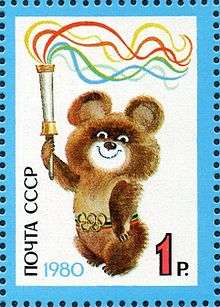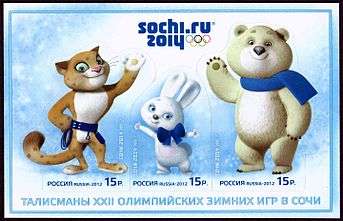List of Olympic mascots
The Olympic mascots are fictional characters, usually an animal native to the area or human figures, who represent the cultural heritage of the place where the Olympic and Paralympic Games are taking place. The mascots are often used to help market the Olympic Games to a younger audience, in particular toddlers and children. Since the 1968 Winter Olympics in Grenoble, France the Olympic Games have had a mascot. The first major mascot in the Summer Olympic Games was Misha in the 1980 Summer Olympics in Moscow. Starting with the 2010 Vancouver mascots, the Olympic and Paralympic mascots have been presented together.
History
The first Olympic mascot was born at the Grenoble Olympic Games in 1968. It was named “Schuss” and it was a little man on skis, designed in an abstract form and painted in the colors of France: blue, red and white.[1] However, the first official Olympic mascot appeared in the 1972 Summer Olympics in Munich. It was Waldi, a Dachshund dog, a popular breed in Bavaria and it represented the attributes required for athletes – resistance, tenacity and agility. On it we can see three of the colors of the Olympic flag (blue, yellow, green).[1][2][3]
The success of those first mascots helped the idea of a mascot become a symbol of the Olympic Games and developed into an institution. Mascots are very popular and despite the importance of the message they convey, they are designed in simple manner with bright, happy colors appropriate for the ‘festive’ atmosphere of the Olympic Games.
The mascots for the 2004 Olympic Games in Athens, were Phevos and Athena, two dolls inspired by a bell-shaped archaic sculpture that is on display at the National Archaeological Museum of Athens. In ancient times, these dolls, the ‘daidala’, as they were called, were also items of worship as well as toys. Phevos and Athena are brother and sister and so they symbolize the joy of play and the values of Olympism. The choice of a brother and sister was purposely made to promote the values of equality and brotherhood.
Olympic mascots
| Games | City | Mascot | Character | Designer | Significance | Photograph |
|---|---|---|---|---|---|---|
| 1968 Winter Olympics | Grenoble | Schuss | Stylized skier | Mme Lafargue | (unofficial) | |
| 1972 Summer Olympics | Munich | Waldi | Dachshund dog | Otl Aicher | A popular breed in Bavaria, it represented the attributes required for athletes – resistance, tenacity and agility. | |
| 1976 Winter Olympics | Innsbruck | Schneemann | Snowman | Walter Pötsch | It represents the Games of Simplicity. | |
| 1976 Summer Olympics | Montréal | Amik | Beaver | Yvon Laroche, Pierre-Yves Pelletier, Guy St-Arnaud and George Huel | One of the national symbols of Canada. | |
| 1980 Winter Olympics | Lake Placid | Roni | Raccoon | Donald Moss | Its face design resembles the hat and goggles used by competitors. Named for the Adirondack mountain range. | |
| 1980 Summer Olympics | Moscow | Misha | Bear cub | Victor Chizhikov | The bear was the national symbol of the Soviet Union. |  |
| 1984 Winter Olympics | Sarajevo | Vučko | Little wolf | Joze Trobec | Symbolizing the desire of humans to befriend animals. 1=According to the IOC, it helped change the common perception in the region of wolves as frightening and blood-thirsty. | |
| 1984 Summer Olympics | Los Angeles | Sam | Bald eagle | Robert Moore (from The Walt Disney Company) | The symbol of the United States. | |
| 1988 Winter Olympics | Calgary | Hidy and Howdy | Two polar bears | Sheila Scott | Both represent Western Canadian hospitality. | |
| 1988 Summer Olympics | Seoul | Hodori | Tiger cub | Hyun Kim | Common in Korean legends. |  |
| 1992 Winter Olympics | Albertville | Magique | Man-star/snow imp | Philippe Mairesse | ||
| 1992 Summer Olympics | Barcelona | Cobi | A Catalan sheepdog | Javier Mariscal | Drawn in avant-garde, cubist style | |
| 1994 Winter Olympics | Lillehammer | Håkon and Kristin | Two Norwegian children | Both are dressed in Viking clothes. | ||
| 1996 Summer Olympics | Atlanta | Izzy | An abstract figure | John Ryan | The first computer-generated mascot. | |
| 1998 Winter Olympics | Nagano | The Snowlets: Sukki, Nokki, Lekki and Tsukki | Four owls | Representing the four major islands of Japan. The first syllable of each name combines phonetically to create the word "Snowlets". | ||
| 2000 Summer Olympics | Sydney | Olly (from "Olympic") | Kookaburra | Jozef Szekeres, Matthew Hatton | Representing the Olympic spirit of generosity. | |
| Syd (from "Sydney") | Platypus | Representing the environment and energy of the people of Australia. | ||||
| Millie (from "Millennium") | Echidna | Representing the Millennium. All three mascots are common wild animals found in Australia. | ||||
| Fatso the Fat-Arsed Wombat (unofficial; an allusion to "The Battlers' Prince") | Wombat | Paul Newell with Roy & HG | Created in protest against the commercialization of Olympic Mascots, this unofficial symbol ultimately became more popular than the official mascots. |  | ||
| 2002 Winter Olympics | Salt Lake City | Powder (a.k.a. Swifter) | Snowshoe hare | Steve Small, Landor Associates and Publicis[4] | All three mascots are indigenous animals of the U.S. state of Utah, and are named after natural resources important to the state's economy. These animals are major characters in the legends of local American Indians, and these legends are reflected in the story of each mascot. To remind them of this heritage, all mascots wear a charm around their neck with a petroglyph image.[5] | |
| Copper (a.k.a. Higher) | Coyote | |||||
| Coal (a.k.a. Stronger) | American black bear | |||||
| 2004 Summer Olympics | Athens | Athena and Phevos | Brother and sister | Spyros Gogos | Two modern children resembling ancient Greek dolls. | |
| 2006 Winter Olympics | Turin | Neve and Gliz | A humanized snowball and ice cube | Pedro Albuquerque | ||
| 2008 Summer Olympics | Beijing | The Fuwa: Beibei, Jingjing, Huanhuan, Yingying, Nini | Fish, giant panda, Olympic Flame, Tibetan antelope, swallow | Han Meilin | The five names form the Chinese phrase "Beijing huan ying ni" (北京欢迎你), which means "Beijing welcomes you". Each representing an Olympic ring and Feng Shui element. | |
| 2010 Winter Olympics | Vancouver | Miga | Mythical sea bear | Meomi Design (a group of Vicki Wong and Michael Murphy) | Part orca and part kermode bear | .jpg) |
| Quatchi | A sasquatch | From Canadian mythology | .jpg) | |||
| Mukmuk | A Vancouver Island marmot | Not an official mascot, but their designated "sidekick". | ||||
| 2012 Summer Olympics | London | Wenlock[6] | Drops of steel with cameras for eyes. | Iris[7] | Named after the village of Much Wenlock in Shropshire – which hosted a precursor to the modern Olympic Games in the 19th century. It represents the UK's start of the Industrial Revolution. | .jpg) |
| 2014 Winter Olympics | Sochi | Bely Mishka (Polar Bear), Snow Leopard (leopard), Zaika (the dore hare) | Silvia Petrova, Vadim Pak, Oleg Serdechny | First mascots decided by popular vote. |  | |
| 2016 Summer Olympics | Rio de Janeiro | Vinicius | An animal representing all Brazilian mammals | Luciana Eguti and Paulo Muppet | Inspired by Brazilian fauna. Named after the poet and bossa nova composer Vinicius de Moraes decided by popular vote. | |
| 2018 Winter Olympics | Pyeongchang | Soohorang | A white tiger | ??? | On 27 June, 2014, the Pyeongchang Olympic Committee notified the public of their mascot selection contest.[8] The selection process took place from 15–30 September 2014. | |
| 2020 Summer Olympics | Tokyo | TBA | TBA | TBA | ||
| 2022 Winter Olympics | Beijing | TBA | TBA | TBA |
Youth Olympic mascots
| Games | City | Mascot | Character | Designer | Significance | Picture |
|---|---|---|---|---|---|---|
| 2010 Summer Youth Olympics | Singapore | Lyo and Merly | Red male lion (Lyo), Blue female merlion (Merly) | Cubix International | The two characters are an allusion to the "Lion City" label of Singapore, and the Merlion, a national symbol of Singapore, respectively. | |
| 2012 Winter Youth Olympics | Innsbruck | Yoggl | Alpine Chamois | Florencia Demaría and Luis Andrés Abbiati of Argentina | Yoggl represents the character of the host city of these games[9] |  |
| 2014 Summer Youth Olympics | Nanjing | LeLe(砳砳)[10] | Rainflower Stone/Yuhua Stone (雨花石) | LeLe is inspired by a unique natural feature of the host city known as the "Rain-Flower Pebble" (also translated as "Riverstone"). The design of the mascot takes the typical shape and appearance of this stone but in a creative and artistic way, highlighting the colours from the emblem’s palette. The word ‘lele’ represents the sound of stones colliding together and is pronounced like the Chinese word meaning happiness or joy. | ||
| 2016 Winter Youth Olympics | Lillehammer | Sjogg | Lynx | Line Ansethmoen | ||
| 2018 Summer Youth Olympics | Buenos Aires | TBA | TBA | TBA | ||
| 2020 Winter Youth Olympics | Lausanne | TBA | TBA | TBA |
See also
References
Notes
- 1 2 "History of Olympic Mascots 1968–2014 – Photos & Origins". www.olympic.org. Retrieved 2015-10-22.
- ↑ "Olympic Games Mascots". www.topendsports.com. Retrieved 2015-10-22.
- ↑ "Ολυμπιακές Μασκότ Χειμερινοί Αγώνες – Athens Info Guide". www.athensinfoguide.com. Retrieved 2015-10-22.
- ↑ Utah Travel Industry. "2002 Winter Olympics: Emblems and Mascots". Retrieved 3 November 2010.
- ↑ Salt Lake Organizing Committee (2001). Reach: An Educators Guide to the Olympic Winter Games and Paralympic Winter Games of 2002. p. 16. Retrieved 20 October 2010.
- ↑ Farquhar, Gordon (19 May 2010). "BBC Sport – London 2012 unveils Games mascots Wenlock and Mandeville". BBC Online. BBC Online. Retrieved 19 May 2010.
- ↑ "2012 London Mascots launched to the World". Retrieved October 21, 2015.
- ↑ "2018평창동계올림픽대회 및 장애인동계올림픽대회 마스코트 아이디어 공모".
- ↑ "Olympic News – Official Source of Olympic News | Olympic.org". www.innsbruck2012.com. Retrieved 2015-10-22.
- ↑ "Nanjing 2014 Youth Olympic Games Mascot Unveiled". www.olympic.org. Retrieved 2015-10-22.
External links
- Official site of the Olympic Movement – Images and information on every game since 1896
- OlympicHistory.info: Mascots (Russian)
- Canadian Olympic Mascots 1976 – 2010